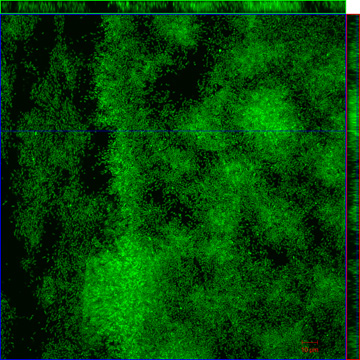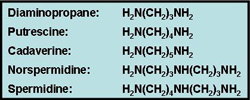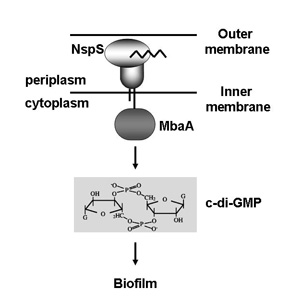Karatan Lab
Vibrio cholerae Biofilms
Appalachian State University
Department of Biology
Rankin Science North
319 (Office), 303 (Lab)
828-262-6742
Biofilms are communities of microorganisms that live attached to surfaces (Fig. 1). In many cases, biofilm microorganisms secrete various macromolecules including polysaccharides, proteins, and DNA which become part of a highly hyrated matrix that encases these organisms. Living in a biofilm affords protection to its inhabitants from chemical (antimicrobials) and physical (UV radiation, dessication) assaults and can therefore be advantageous. As far as we know almost all bacteria can make biofilms under the right conditions. These conditions are dictated by environmental cues. Switching from a planktonic (free-swimming or free-floating) existance to living in a biofilm is a "life-style" decision that a microorganism makes based on these cues.

Figure 1. Transverse and vertical cross sections through SYTO 9-stained wild-type V. cholerae biofilms formed on glass coverslips after overnight incubation in LB broth. The transverse sections were obtained at the level of the substratum. (Bar :10 µm.) Biofilms were visualized using a Plan-Neofluar ×40/1.3 oil objective lens and images were acquired and analyzed using a LSM 510 confocal scanning system (Zeiss, Thornwood, NY) at William C. and Ruth Ann Dewel Microscopy Facility.
Vibrio cholerae, the causative agent of the devastating diarrheal disease cholera, is able to form biofilms on a variety of surfaces. This bacterium is both an inhabitant of aquatic environments worldwide and a human pathogen. The ability of this organism to form biofilms is important for its survival both in its natural environment and in the human host. Biofilm formation in V. cholerae is regulated by a variety of environmental signals monosaccharides, nucleosides, quorum sensing signals, bile salts, indole, and polyamines. In the Karatan lab, we are interested in regulation of biofilm formation in V. cholerae by polyamines. Polyamines are small aliphatic hydrocarbons containing two or more amine groups which are positively charged at physiological pH (Fig. 2). They are made by virtually all organisms and are necessary for normal cell growth.

Figure 2: Polyamines found in V. cholerae grown in LB.
We have previously shown that the triamine, norspermidine, enhances biofilm formation in V. cholerae (Karatan et al. 2005). Norspermidine is thought to exert its effect by a putative signaling complex made up of NspS and MbaA proteins. Because MbaA is a GGDEF/EAL family protein, we hypothesize that norspermidine regulates biofilm formation by altering local or global c-di-GMP pools (Fig. 3). Currently, we are elucidating the details of this system.

Figure 3. Schematic drawing showing the predicted cellular location of the NspS and MbaA proteins. The zigzig line denoted norspermidine. The working model proposes that norspermidine binds NspS which is hypothesized to be in a complex with MbaA, resulting in inceases in c-di-GMP concentrations and biofilm formation.
(For more details on the various ongoing projects please look at invidual webpages of the graduate students)